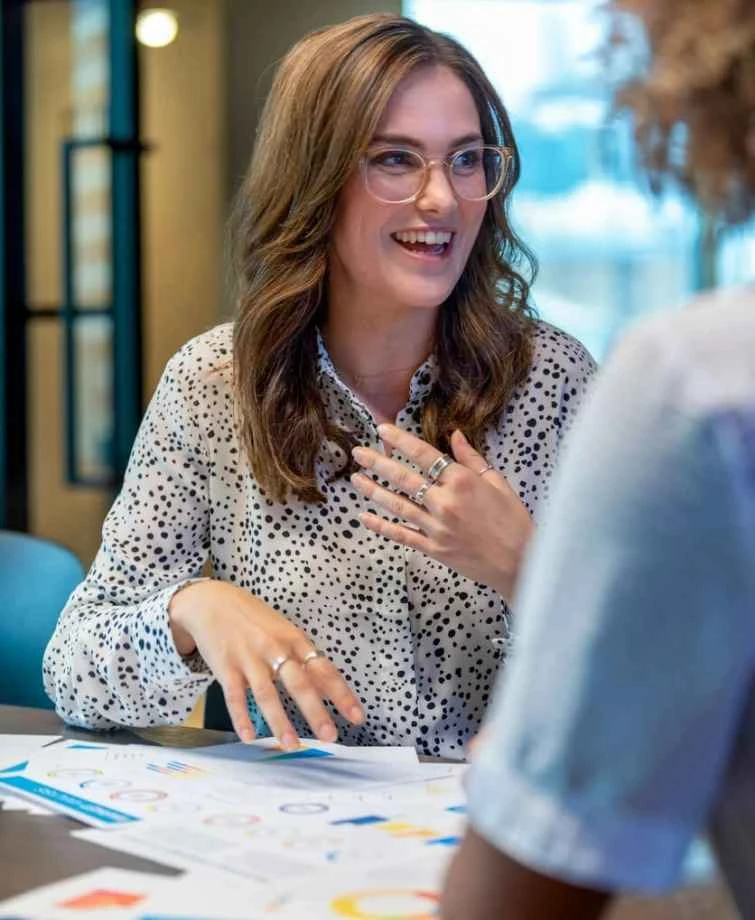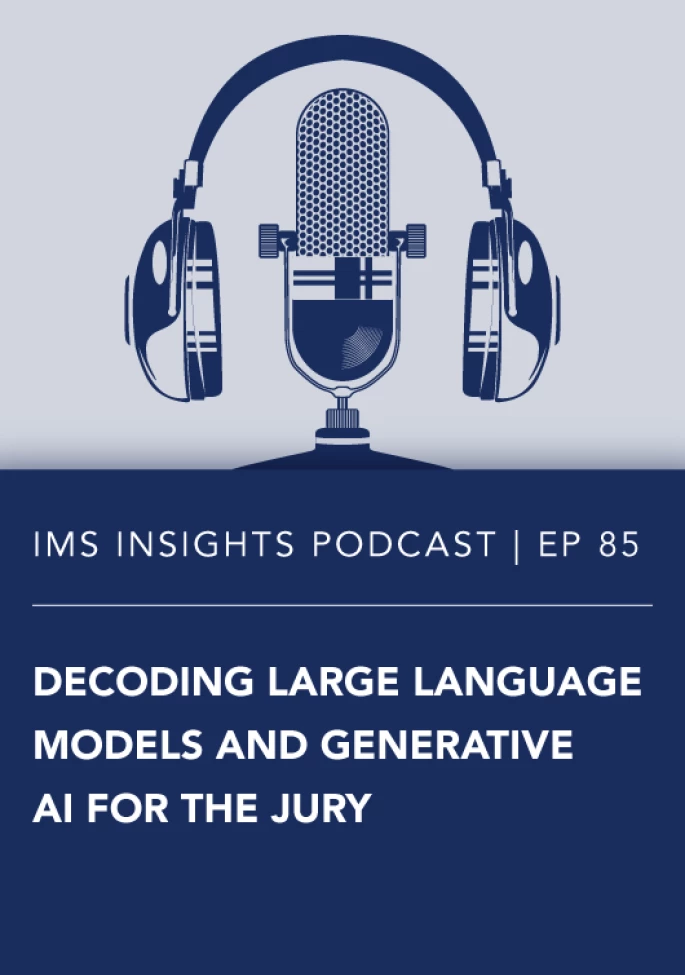In this episode of the IMS Insights podcast, we speak with Britta Stanton, JD, about how attorneys can leverage the tools of persuasion at trial and in virtual settings.
The Role of Perspective in Advancing Persuasion at Trial & in Virtual Settings | Episode 10
05.13.20
|Categories
| Hosted by Teresa Barber, former IMS Director of Industry Relations
Teresa Barber: So, Britta, welcome. So glad to have you here. Could you tell us a little bit about your background? How did you initially become interested in law?
Britta Stanton: I think I've always been interested in the art of persuading people, having that ability to talk to a jury and have them see the world the way I was seeing it was very interesting to me and because of that, in part, I went into advertising for my undergraduate degree and I remember my dad worked as an expert witness often at that time and he said, "Man, we really need some of these things you learn as an advertiser for these lawyers to use because they're so boring and they don't explain things well to our juries."
Stanton: So those things kind of went together in my mind and I was the age in college that I realized I was going to have to graduate and get a real job. So at that point, the idea of three more years of law school didn't sound so daunting. So that's when I decided to go ahead and go to law school and I picked a school that was very big on advocacy because that's what I wanted to do.
Barber: Very interesting. Then so you were a practicing trial attorney, that's right, right?
Stanton: That's correct. Since 2002 I've been a practicing lawyer and didn't resign my partnership until 2019.
Barber: So, what made you make that decision to move from practicing to want to advise clients, want to work with clients in that arena?
Stanton: It's something I've always wanted to do ever since I realized there were people who just did that all day long. I remember the day that Chris Ritter walked into a conference room at my law firm and sat down with myself and my mentor and he talked about the case and he brought all these great ideas in and I remember thinking, "Man, he has the coolest job." That was when my third child was still a twinkle in my eye, so I know it was at least 10 years ago, and I always thought he had a really great job and I've patterned my career to get into the courtroom more and more often and to work with witnesses and juries more and more often. Then finally I decided to make the plunge and be a Chris Ritter.
Barber: So now that you've made that crossover, what have you really been enjoying about advising clients
Stanton: It's so nice to be able to come in and think only about the persuasion piece of a case. To think about the witness, how the witness is going to come across to the finder of fact, to think about how the jury is going to start to learn these concepts, what visual things or cues you can use to help the jury learn these concepts, to work with an expert to make something that he or she has been doing their whole lives that's so complicated simple enough for any jury or any judge to understand. It's really nice to have the luxury to come in and start as a blank fresh slate with a new case and a new client and say, "I don't know anything about this and I'm a reasonably intelligent person and this is really confusing, so let's break it down in a way the jury is going to understand."
Stanton: When I did that as a lawyer, it was much more difficult because I would be burdened with all the information that I knew. I would be burdened with all of the things, I was worried about as far as getting things into evidence and how are we going to make this admissible and what do we do about that and, "Oh we should file a motion on this and let me add that to my motion and lemony." Whereas now, as a consultant, I come in with a sole focus of how are we going to teach and persuade.
Barber: That's interesting because you've had both perspectives, as the attorney on the matter and then being able to come in with a fresh outside neutral perspective and put those pieces together. What's the benefit to clients, to attorneys on the case? What is the benefit of having someone on the outside, specifically related to persuasion, to be able to come in and put these pieces together?
Stanton: I know firsthand that lawyers have such a tough job, thinking about so many different things all at once. So, coming in with a fresh perspective is really valuable. For example, if I'm a lawyer on this case and I'm fighting for a document, and the other side won't give it to me and I know it's there and then I file a motion to compel and it's a hard-fought motion and I win the motion and I get the document, I've spent a lot of money in legal fees and a lot of time and effort getting this document and I look at it and it's okay, but I've now convinced myself that this document is the cornerstone of the case and I'm so mad and I want to tell the jury later how hard I had to fight to get this document and how the other side was trying to hide it.
Stanton: As the consultant, I can come in as a blank slate and look at the document and say to my client, "Ah, it's not really that important to the case," and I don't have that emotional attachment to that fight that I've had already. So that's easier. Then the other part is being a lawyer kind of shuts down your creativity. Legal writing, while persuasive, isn't creative writing and lawyers think in lawyer land and in word land and consultants can come in and help the lawyer figure out how to translate word land into a place where most jurors are more comfortable, which is with bigger concepts, with graphics and infographics, pictorial ideas and ways to speak to the different types of juries or jurors that you're going to get in a case so that you're not second word land and leaving your jurors behind.
Barber: That's interesting. So, you talk about creativity and you and I have had some conversations about storyline and theme. So how, as an outsider or if I'm just thinking about story land line and theme for the first time, how important is that for building a case and how do you help clients put those pieces together and tap into their creativity to make it go?
Stanton: We always ask clients to tell us the story of their case. It is very common for clients to come to us and say, "Well, obviously we need a timeline," and that's true, you almost always need a timeline in a case, but the way you actually craft the order of your story and create plot and drama is very important. It can be hard for lawyers to break away from just a chronological, "Here's what happened first and then this and then this and then this," but a lot of disputes, especially commercial disputes, which I've worked on a lot in my lifetime, they are about missed expectations. So, if you start at a different point in the story, perhaps start at the place where the expectations were set, and then show how they were missed and then show the representations that created the expectations—that type of storyline can create a lot more drama and interest for the jury.
Stanton: At the end of the day you can have a really great story, but if the jury is too bored or if it's too complicated for the jury to listen to it, you're probably not going to be persuasive and successful. So, creating an actual story of the case is different than just giving a chronological timeline of the things that happened. There's always an opportunity to create some sort of drama where you look at your client and you think, "Well they were disappointed," or "They were shocked this happened," or "This isn't the bargain they thought they were getting." There's always something like that, so to pick out that drama in the case is really valuable for the jury who ends up listening to it to be interested and excited and want to right that wrong.
Barber: So, without disclosing anything confidential do you have a favorite case where you helped a client use story or theme or drama in a way that really was compelling and really helped bring that victory about
Stanton: Sure. We do it all the time and a lot of times it happens with the order of telling a case, but one of my most unusual circumstances was when we represented a company that was part of making a really gigantic, complicated, expensive...and when I say gigantic, I mean physically gigantic piece of equipment. This piece of equipment was cool and our clients were very uncool and our clients also had some translation problems. They needed interpreters to talk, they were very formal.
Stanton: So, the big idea for this case was to anthropomorphize this piece of equipment. We made this piece of equipment; it already had a name. I'm like, "Let's not call it the technical name, let's give it the human name that we call it. Let's talk about how cool it is and when the other side attacks are our story and our case, let's make them attack this really cool robot we basically have." So that was the way we helped the jury connect with our client.
Barber: That's interesting and you're talking about this big physical object and bringing it into the courtroom and here we are amid COVID-19, major pandemic, a lot of disruption, especially in cities like New York and we're seeing some courts move hearings into teleconference or into video conference. How can those tools of persuasion be brought into potentially a virtual environment? Do you have any guidelines that you've been sharing with clients or seeing any questions from them that might be helpful to our listeners?
Stanton: Yeah, absolutely. Some courts are doing teleconference, and some courts are doing video teleconference. I have been incredibly pleased and impressed with the courts I've seen, at least locally in Dallas, have really been pushing and starting things as video conference. I thought we would have to do a lot more education and pushing the judges to hold a video conference versus just a telephone conference, but that has not been the case.
Stanton: So, the real lag is coming with lawyers or their clients who are serving as witnesses in a video hearing by not showing up with a video camera. So it's really important that everyone get their iPad or their phone or their laptop with a webcam and make sure they're ready to prepare and present as a video, not just a telephone conference, for a video hearing or a remote hearing because it's much more persuasive to be able to be seen by someone, you know the court's paying attention, you're looking them in the eye as you're looking at your video camera and presenting to them and to make sure your witness does the same thing.
Stanton: It is vital to make sure your witness is prepared to do that. I've seen some people try and do it where witness is in the same room with the lawyer so that they're in a conference room together talking to the judge. That can be really tricky because when we're looking at video teleconferences, we're looking at them on tiny screens and someone's head gets shrunk to the size of a quarter, so if you're fitting in two heads, they're even smaller. So you have to be aware of things like that, but if you get your client on their own screen and make sure they either have a headset or are in a separate room from you so there's no feedback problems, it can be almost as effective as live and living color to have a video teleconference hearing.
Stanton: Also, it's really easy to use exhibits and PowerPoints or other persuasive graphics and documents to keep everyone on the same page, especially if you dial into a video teleconference with a separate screen so that you can present things or have your paralegal or an assistant dial in the separate screen and present things. Everyone can then see your face, the witness's face, if they're testifying, the exhibits, and it's all there in the record depending upon how the court is saving them for their court reporters and the court reporters are really coming along on this quickly too. They have Drop boxes or other things set up. They're telling you what kind of naming convention they want. The courts are issuing orders saying, "Give these to opposing counsel X number of hours before the hearing." So the courts are ready. So if you're showing up at a video teleconference and you think you're just going to muddle through on your telephone, you've got another thing coming. You need to get ready and prepare for those video teleconferences because the courts are really knocking it out of the park.
Barber: That's helpful. Yeah, and I've heard about some pretty successful early stage advising sessions you've had with clients recently. We call them mental mining sessions. Tell me how that has been working a virtual environment.
Stanton: It's interesting because we'd really been pushing to try to do mental mining sessions, which are strategy sessions that we conduct with lawyers and out of those mental mining sessions come great ideas for graphics and structures for mock trials and things like that. We've been pushing to try and conduct those remotely because sometimes it's just expensive to travel to do something with someone in person and while I love to do them with a lawyer in the lawyer's conference room, the costs just sometimes are not feasible.
Stanton: So, we had been setting up a system where we can have two different people, so one would be me in person over video and the other would be my iPad in person over video set up and dial into the same call with the lawyers. That way I can do all sorts of white boarding and take notes and things that everyone can see who's in the video teleconference on my iPad while I draw on it but sit there and they can still see my face, and it works amazingly well. We've known that the technology was there, we just hadn't really done it a whole lot, and now that we have these mandates to stay home, we're doing it a lot more often and it works, it works very well and there's a great record of the meeting and all the notes you took at the end because you've been sharing them on your screen the whole time.
Barber: Could you break it down for us, explain what exactly is a mental mining session or that early-stage strategy advising? I know you follow a very precise method for it. So, can you help us get our heads around what is mental mining? What is that advising?
Stanton: Sure. In some ways I like to describe what it's not or what happens when you don't have it. I remember as a lawyer being very dissatisfied with graphics vendors who would come to my office, take my scribbled down notes from a piece of paper and turn them into scribble down notes in digital ink, usually filled with typos and with no original ideas even though I would say, "Well this is the kind of thing I want to explain," and I didn't have the time or the creativity to sit there and think about this, that and the other and how we might best persuade someone and how this document or timeline might be most persuasive because I was busy working on a brief or a direct examination outline or figuring out how I was going to get which exhibits into evidence.
Stanton: The Focal Point was different. The Focal Point would come and they would give me the things that I'd scribbled down on a piece of paper, but even if I didn't ask them for it, they would always offer other ideas to me, "Well, here's a basic timeline like you wanted, but what if we did this? Or how about this idea?" and I really felt like I got a partner when I worked with The Focal Point. It wasn't until later that I realized the reason why I felt like that was because we were having a mental mining strategy session, that we were thinking about what's the big picture in our case, what do we want to prove, what are our major themes, and then the graphics would flow from that. Rather than trying to cram the graphics in after the fact, we would all make sure we were on the same page about themes together and then we would take those themes and they would be distilled through the graphic process.
Related Industry Insights
-

11.26.25
Podcast |
Related Industry Insights
Mental Mining: Uncovering Your Case Story | Episode 87
-

11.12.25
Podcast |
Related Industry Insights
More Than Pretty Pictures: The Power of Trial Graphics | Episode 86
-

10.29.25
Podcast |
Related Industry Insights
Decoding Large Language Models and Generative AI for the Jury | Episode 85

IMS partners with the most influential global law firms and corporations to elevate their legal strategies. Our trusted expertise is hard-earned. Together, we win.





